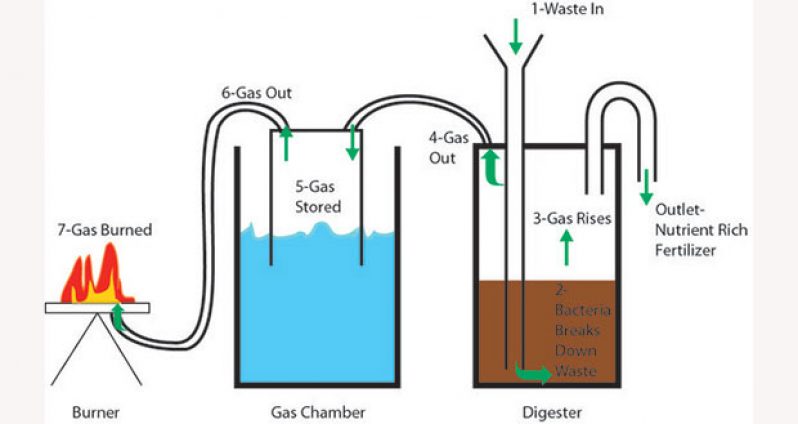By Rabindra Rooplall
LIVESTOCK farmers are being encouraged to install bio-digester units (BDUs) on their farms to enable them to produce biogas, as this can bring them long-term benefits with cash savings, according to the Guyana Energy Agency (GEA).Biogas is produced by the breakdown or decomposition of organic waste in the absence of oxygen, and comprises a mixture of gases, mainly carbon dioxide and methane, which can be used as an alternative energy source instead of firewood and fossil fuels.
“A bio-digester unit is a clean, healthy and economic alternative, since it not only provides fuel for domestic household use, but also provides liquid and solid fertilizers that can be used in farming. This, in turn, aids in reducing the amount of chemical contaminants (in organic fertilizers) that affect human health and the environment,” the GEA has underscored.
The agency disclosed that it has both been supporting the installation of bio-digesters and monitoring their use. There are at present over thirty (30) bio-digesters installed in Guyana, and these use organic materials to produce biogas.
GEA encourages livestock farmers (cattle, pig, etc) that the production of methane gas will help to conserve on imported energy sources (fossil fuels), thereby allowing for savings on energy bills and a positive contribution to the environment.
“There are many raw materials (organic materials) from which biogas can be extracted; for example, animal manure, leaves, twigs, grasses and garbage, among others. Biogas production from animal waste provides a unique opportunity to mitigate the effects of waste produced on farms while providing a cheap and sustainable source of energy,” the GEA underscored.
“To facilitate the production of biogas, a structure referred to as a bio-digester unit (BDU) is used. A bio-digester aids in the decomposition of organic materials, such as those listed above, to produce methane gas (biogas) that can be used for cooking, heating, lighting (using gas lamps), electricity generation, operation of farm machinery, and other energy needs.
“The decomposition of waste material during anaerobic digestion is caused by bacterial action rather than high temperatures. It takes place in almost any biological environment, but is favoured by warm, wet and low-oxygen conditions. Anaerobic digestion also occurs in two major situations created by human activities: sewage (human waste) or animal manure. Landfill gas is produced by domestic refuse buried at landfill sites.
“In nature, there are also many raw materials (organic materials) from which biogas can be extracted: human and animal manure, leaves, twigs, grasses, garbage, agricultural and industrial wastes with organic content greater than 2%. The biogas produced can be used for cooking, heating, lighting (using gas lamps), electricity generation, operation of farm machinery and other energy needs.
“The effluent produced from the process can be used as a fertilizer for crops.
The cost to set up a bio-digester, including parts and labour, should be approximately $120,000 and would replace the need for at least one 20-lb LPG gas cylinder per month. The simple payback for the installation based on an average cost of $3,600 per 20-lb LPG gas is just under three years. After year three, except for basic maintenance and labour, all gas produced will be free.
“Biogas is primarily used as a fuel for cooking purposes and electricity generation. Scientific advances have significantly enhanced biogas yield production, leading to the development of commercial or large/medium scale biogas plants in recent years.
“In terms of both consumption and production of biogas, Europe leads the other nations mainly due to increased government regulation for renewable energy initiatives.
“The German experience is particularly impressive. Since the introduction of feed-in-tariffs for biogas in Germany, over 7,000 biogas plants have been developed and are on target to develop 17% of power from biogas. However, although Europe dominates biogas production, the technology application is fast increasing in Japan, Australia, New Zealand and the United States. The Asia-Pacific biogas plants’ market is displaying strong appetite for growth, especially in the emerging markets such as China and India.
Global Analysts Inc reports that the global biogas plants’ markets will reach $8.98 billion by the year 2017. The desire to reduce dependency on fossil fuels, heightened attention to eco-friendliness, and government incentive programmes will continue to grow investment in biogas facilities.




.png)









